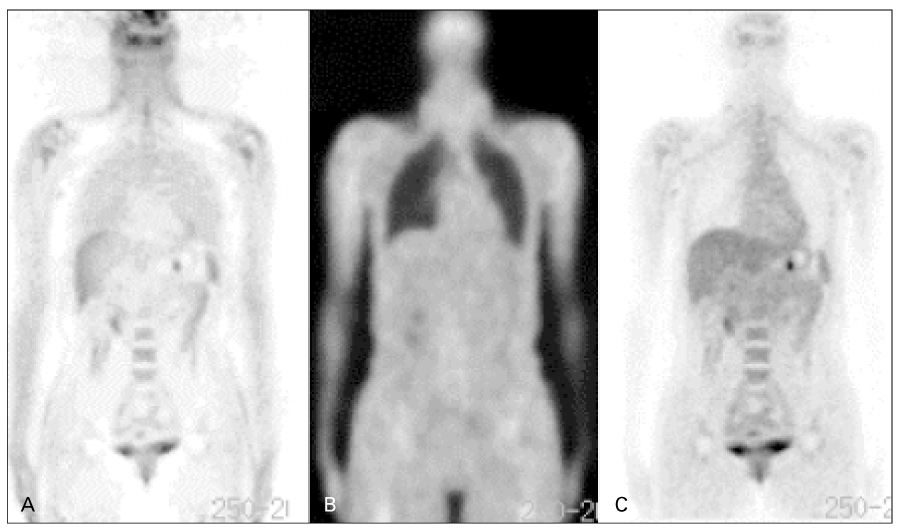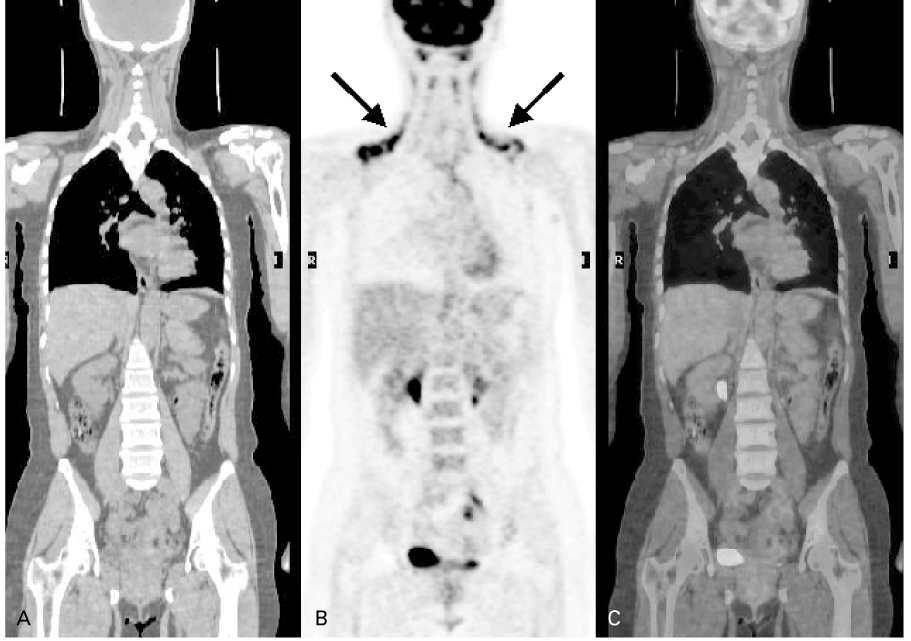 |
 |
- Search
| J Korean Med Assoc > Volume 47(9); 2004 > Article |
Abstract
PET using FDG has been proposed as a functional whole body imaging modality that images various types of malignancies with relatively high sensitivity and specificity in a reasonably short time. It depicts a lesion based on abnormal glucose metabolism whereas CT as a high-resolution anatomical imaging detects malignant process mostly based on altered anatomy. PET/CT combines the advantages of PET and CT, and has a great value in early detection of disease, accurate staging or restaging, early assessment of treatment response, decision on therapeutic plans, and rapid localization of recurrence. Exact anatomical localization of a lesion with increased FDG uptake by CT is considered to be the most important factor that improves the diagnostic accuracy of PET/CT. So far, limited studies have been reported using PET/CT in comparison with PET only and mainly proved additional value of PET/CT in malignant tumors in which conventional PET already had advantages over anatomical imaging. PET/CT appears to have a promising role in the field of radiotherapy planning. Another potential of PET/CT would be in the evaluation of tumors with low FDG uptake by way of CT or new PET tracers. PET/CT is in the stage of its early infancy and further studies remain to be performed to establish applications of PET/CT in clinical oncology. In this review, we will discuss the principle of PET, the background of the emergency of PET/CT, advantages, pitfalls, and debates of PET/CT along with clinical applications and future perspectives of thereof.
References
1. Kinahan PE, Townsend DW, Beyer T, Sashin D. Attenuation correction for a combined 3D PET/CT scanner. Med Phys 1998;25:2046-2053.
2. Warburg O, Wind F, Negleis E. On the metabolism of tumors in the body. The metabolism of tumours 1930;254-270.
3. Mac Manus M, Hicks R, Ball D, Kalff V, Matthews J, McKenzie A, et al. F-18 fluorodeoxyglucose positron emission tomography staging in radical radiotherapy candidates with nonsmall cell lung carcinoma : powerful correlation with survival and high impact on treatment. Cancer 2001;92:886-895.
4. Schoder H, Erdi YE, Larson SM, Yeung HW. PET/CT : a new imaging technology in nuclear medicine. Eur J Nucl Med Mol Imaging 2003;30:1419-1437.
5. Cohade C, Osman M, Pannu HK, Wahl RL. Uptake in supraclavicular area fat ("USA-Fat") : description on 18F-FDG PET/CT. J Nucl Med 2003;44:170-176.
6. Lardinois D, Weder W, Hany TF, Kamel EM, Korom S, Steinert HC, et al. Staging of non-small-cell lung cancer with integrated positron-emission tomography and computed tomography. N Engl J Med 2003;348:2500-2507.
7. Czernin J. Summary of Selected PET/CT Abstracts from the 2003 Society of Nuclear Medicine Annual Meeting. J Nucl Med 2004;45:S102-S103.
8. Ciernik IF, Dizendorf E, Baumert BG, Reiner B, Burger C, Von Schulthess GK, et al. Radiation treatment planning with an integrated positron emission and computer tomography (PET/CT) : a feasibility study. Int J Radiat Oncol Biol Phys 2003;57:853-863.
9. Esthappan J, Mutic S, Malyapa RS, Grigsby PW, Zoberi I, Low DA, et al. Treatment planning guidelines regarding the use of CT/PET-guided IMRT for cervical carcinoma with positive paraaortic lymph nodes. Int J Radiat Oncol Biol Phys 2004;58:1289-1297.
10. Schoder H, Larson SM, Yeung HW. PET/CT in oncology : integration into clinical management of lymphoma, melanoma, and gastrointestinal malignancies. J Nucl Med 2004;45:Suppl 1. S72-S81.
11. Cook GJ, Wegner EA, Fogelman I. Pitfalls and artifacts in FDG PET and PET/CT oncologic imaging. Semin Nucl Med 2004;34:122-133.
12. Antoch G, Freudenberg LS, Beyer T, Bockisch A, Debatin JF. To enhance or not to enhance? 18F-FDG and CT contrast agents in dual-modality 18F-FDG PET/CT J Nucl Med 2004;45:Suppl 1. S56-S65.
13. Schoder H, Yeung HW, Gonen M, Kraus D, Larson SM. Head and Neck Cancer : Clinical Usefulness and Accuracy of PET/CT Image Fusion. Radiology 2004;231:65-72.
14. Wahl RL. Why nearly all PET of abdominal and pelvic cancers will be performed as PET/CT. J Nucl Med 2004;45:Suppl 1. S82-S95.
15. Ho C, Yu S, Yeung D. 11C-acetate PET imaging in hepatocellular carcinoma and other liver masses. J Nucl Med 2003;44:213-221.
16. Shiomi S, Nishiguchi S, Ishizu H, Iwata Y, Sasaki N, Ochi H, et al. Usefulness of positron emission tomography with fluorine-18-fluorodeoxyglucose for predicting outcome in patients with hepatocellular carcinoma. Am J Gastroenterol 2001;96:1877-1880.
17. Torizuka T, Tamaki N, Inokuma T, Magata Y, Yonekura Y, Konishi J, et al. Value of fluorine-18-FDG-PET to monitor hepatocellular carcinoma after interventional therapy. J Nucl Med 1994;35:1965-1969.
18. Kinkel K, Lu Y, Both M, Warren RS, Thoeni RF. Detection of hepatic metastases from cancers of the gastrointestinal tract by using noninvasive imaging methods(US, CT, MR imaging, PET) : a meta-analysis. Radiology 2002;224:748-756.
19. Donckier V, Van Laethem JL, Goldman S, Van Gansbeke D, Feron P, Gelin M, et al. [F-18] fluorodeoxyglucose positron emission tomography as a tool for early recognition of incomplete tumor destruction after radiofrequency ablation for liver metastases. J Surg Oncol 2003;84:215-223.
20. Kato T, Tsukamoto E, Kuge Y, Katoh C, Nambu T, Tamaki N, et al. Clinical role of (18)F-FDG PET for initial staging of patients with extrahepatic bile duct cancer. Eur J Nucl Med Mol Imaging 2002;29:1047-1054.
21. Kluge R, Schmidt F, Caca K, Barthel H, Hesse S, Berr F, et al. Positron emission tomography with [(18)F]fluoro-2-deoxy-D-glucose for diagnosis and staging of bile duct cancer. Hepatology 2001;33:1029-1035.
22. Fritscher-Ravens A, Bohuslavizki KH, Broering DC, Jenicke L, Schafer H, Clausen M, et al. FDG PET in the diagnosis of hilar cholangiocarcinoma. Nucl Med Commun 2001;22:1277-1285.
23. Kim YJ, Yun M, Lee WJ, Kim KS, Lee JD. Usefulness of 18F-FDG PET in intrahepatic cholangiocarcinoma. Eur J Nucl Med Mol Imaging 2003;30:1467-1472.









